Seven Gates to Morocco
Seven Gates to Morocco - referring to the welcoming gates which grace so many Moroccan towns - is an independent custom tour with a very flexible itinerary. Morocco is a year-round destination with warm days and cooler nights, and can be booked on 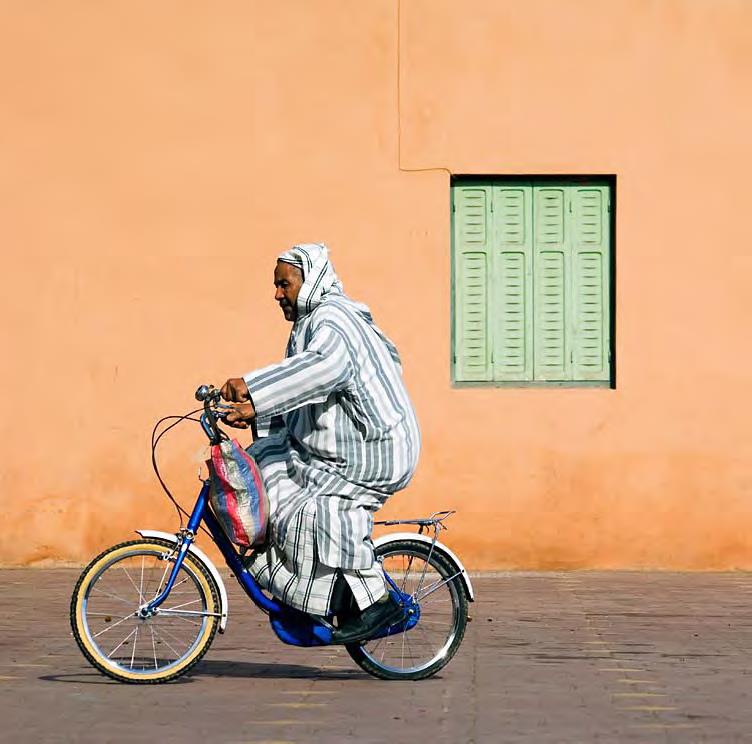 short notice as no entry visa is required.
short notice as no entry visa is required.
Brilliantly colorful and culturally compelling, Morocco has long been held as one of the world’s great travel destinations. Few places offer such stunning variety: From the white beaches of the Atlantic Coast to the snowy mountains of the High Atlas to valleys of wildflowers and palm oases perched on the edge of the Sahara, Morocco is a traveler’s dream. We have handcrafted a trip to leisurely take in our favorite haunts, sip mint tea along the way, and discover the unique history, arts, and food of this part of the world.
Your adventure begins in Rabat, Morocco’s political capital and shimmering city of white facades and palm-lined boulevards, with reminders of Morocco’s French-colonial past. Continue by road through the “bread basket” of Morocco to medieval Fès. Adorned with thin minarets, Fès is famous for its labyrinthine souk (market).
Traverse the High Atlas Mountains, marked by breathtaking panoramas and romantic casbahs to reach the sand dunes of Merzouga, at the edge of the Sahara. The last chapter of this journey leads you to fabled Marrakech. Throughout, your private guide weaves stories of Morocco’s history and cultural traditions, and is a valuable friend in opening opportunities to meet local people and learn firsthand about the country’s rich heritage.
Notably, our camp outside of Erfoud, at the foot of the Saharan dunes is simply appointed and has comfortable Bedouin-style tents with beds, plenty of blankets, and lanterns. Dinner under desert stars, the songs of local musicians, and a great sense of solitude have made this camp a deeply memorable highlight for Morocco travelers. We’ll recall Ogden Nash’s tribute to the drive to “Marrakech [which] traverses landscapes simply socko." As its many will agree, Morocco in toto is delightfully socko.
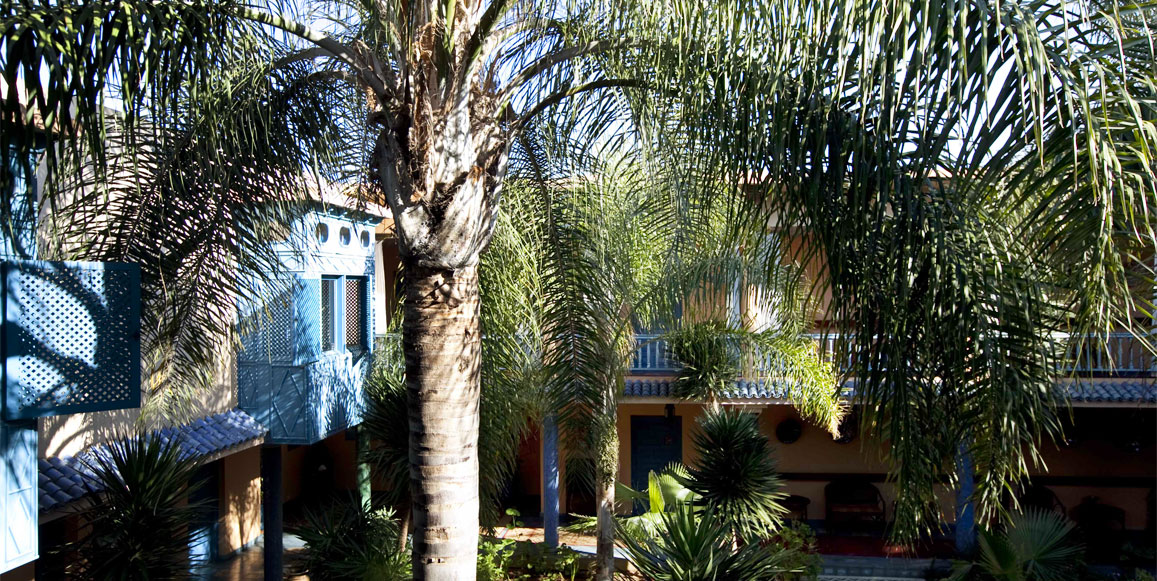
Day 1: Rabat
Upon landing in Rabat, clear immigration and customs and proceed to the arrivals hall. Here, your guide greets you, and together you drive to your riad (traditional Moroccan house or palace with an interior garden or courtyard).
Rabat has hosted its share of invaders. The Phoenicians established a settlement here along the Oued Bou Regreg estuary some 2,500 years ago, followed by the Romans and then the Berber-Muslim Almohad Dynasty (1147–1269), which claimed Rabat as its principal city and base for its conquest of Spain. You see striking evidence of this progression of people just beyond Rabat’s old walls at the ancient site of Chellah, where Roman ruins mingle with an Almohad fortress and necropolis. Under Almohad rule, the city flourished, but when the dynasty fell, Rabat declined. It was abandoned and later brought back to life, becoming the capital of Morocco in 1912.
As time permits, explore a few highlights of the city in the afternoon. Stroll across a broad, flowerbedlined avenue to reach the Royal Palace; the palace is not open to the public, but it’s worth appreciating from the outside. Erected in 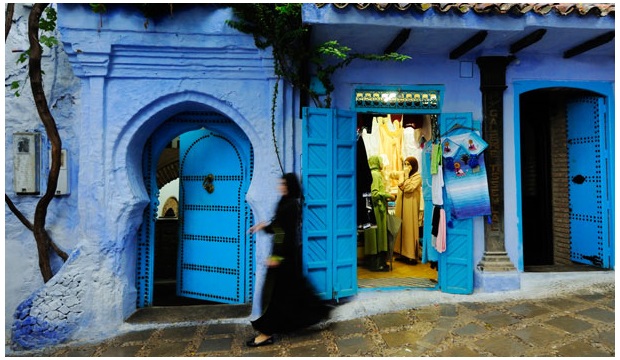 1864, it houses the offices of the Moroccan government and is set among beautiful gardens. From here move on to Hassan Tower, the emblem of Rabat, a massive but only partially built minaret of the vast, never-completed 12th-century Hassan Mosque. Next, venture to the adjacent Mohammed V Mausoleum, home to the marble sarcophagus of independent Morocco’s first king. Royal guards stand at attention as Moroccans pay their respects and admire the artistry of the building. Walk through Bab Ouadaïa, the grand Almohad gate that leads into Ouadaïa, site of Rabat’s original citadel. Once inside, head to the National Jewelry Museum to check out its collection before relaxing in the casbah’s classical Andalusian garden with a revitalizing glass of mint tea.
1864, it houses the offices of the Moroccan government and is set among beautiful gardens. From here move on to Hassan Tower, the emblem of Rabat, a massive but only partially built minaret of the vast, never-completed 12th-century Hassan Mosque. Next, venture to the adjacent Mohammed V Mausoleum, home to the marble sarcophagus of independent Morocco’s first king. Royal guards stand at attention as Moroccans pay their respects and admire the artistry of the building. Walk through Bab Ouadaïa, the grand Almohad gate that leads into Ouadaïa, site of Rabat’s original citadel. Once inside, head to the National Jewelry Museum to check out its collection before relaxing in the casbah’s classical Andalusian garden with a revitalizing glass of mint tea.
From this romantic lookout on the Bou Regreg River, you can see across the water to the fortified town of Salé, historically a hub for Barbary pirates. These corsairs operated from Morocco as well as Tunisia, Libya and Algeria, in order to prey on Christian and non-Islamic ships in the western Mediterranean. After tea, amble through the casbah’s tiny cobbled alleys past whitewashed walls, swathes of blue paint, and decorative doors and wrought iron, feeling a bit like you’ve been transported to southern Spain. La Villa Mandarine (D)
Day 2: Meknès, Volubilis and Fès
Today you will drive east toward the Middle Atlas Mountains and into Morocco’s agricultural heart. Wildflowers and thousands of orange and lemon trees grow along this route. After about two hours on the road, arrive in Meknès, the capital that Sultan Moulay Ismaïl ibn Sharif built in the late 17th century when he ruled the Alaouite Dynasty. The plethora of palaces, mosques, gates, and walls he constructed earned Meknès the moniker “Versailles of Morocco.” Check out the monumental and richly decorated Bab Mansour, the Place el-Hedim (Square of Ruins), and the Dar el-Ma, a huge barrel-vaulted building used to store water and grain.
Next, venture to the nearby ancient city of Volubilis, the Roman Empire’s northwest African capital, now a World Heritage Site. As you walk among the 2,000-year-old ruins and see the vestiges of several remarkably preserved floor mosaics, you gain insight into the Roman influence in Morocco.
Continue east (about one hour) to storied Fès, Morocco’s oldest imperial city and the cultural and spiritual capital of Morocco. Fès’ mysterious, multifaceted character has long held the attention and imagination of writers, poets and explorers the world over. Lord Byron qualified Fès as a place “where all is Eden, or a wilderness.” Total drive time: 4 hours on paved roads. Riad Palais Faraj (B)
Day 3: Fès
In the 1950s, John Gunther suggested that “If you like your romance dark, Fès is probably the most romantic city on earth. It might 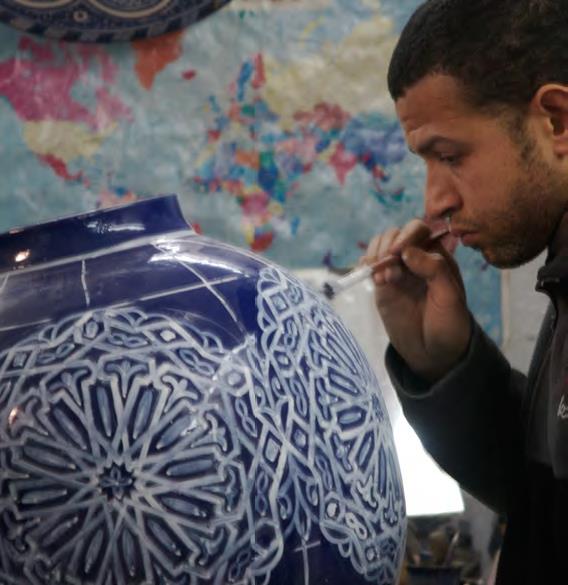 have been dreamed up by Edgar Allan Poe - almost sinister in its secretiveness, a twisted city, warped and closed.” Strolling through Fès’ honeycomb of tiny lanes and crowded bazaars, you’ll be glad to have a guide. Find your way to the vibrant Tannery Quarter, where leather is made much the same way it was in the Middle Ages.
have been dreamed up by Edgar Allan Poe - almost sinister in its secretiveness, a twisted city, warped and closed.” Strolling through Fès’ honeycomb of tiny lanes and crowded bazaars, you’ll be glad to have a guide. Find your way to the vibrant Tannery Quarter, where leather is made much the same way it was in the Middle Ages.
Expand your exposure to the country’s artisan traditions at the Dar el-Batha Palace’s impressive arts and crafts museum, which features embroidery, woodcarving, calligraphy, weaving, ceramics, and more. You can also peek in at a pottery and zellij tile workshop to watch skilled craftsmen hand cut tile and create ornate layouts using designs they’ve learned from previous generations.
Beyond the medina, take in the fantastic views from the 16th-century Borj Sud, one of the two fortresses overlooking the city, and go by the 9th-century Karaouine Mosque. Graced with two minarets and a green tiled courtyard, it is the biggest mosque in Fès and home to Karaouine University, affirmed by the Guinness Book of World Records as the oldest existing educational institution in the world. Nearby stands the gloriously crafted El-Attarine Medersa (medersa means “school”), commissioned by Marinid Sultan Uthman II and built from 1323 to 1325. Return to your hotel for a good night’s sleep.
Riad Palais Faraj (B)
Day 4: Erg Chebbi Dunes
Today you will travel south on a long scenic journey through the Middle Atlas Mountains. Frequent stops give you the chance to stretch your legs and take photographs of the panoramas and Tafilalet palm groves (this region is famous for its one million date-palm trees).
Arrive in the village of Erfoud, gateway to the Sahara. Located at the foot of Jebel Erfoud (jebel means “mountain”) and built by the French as a military outpost and administrative center, Erfoud signals the switch from paved to dirt roads, from two-wheel-drive transport to four. The final 30-minute leg of your voyage takes you across desert tracks to your tented camp in the Erg Chebbi, a sea of sand dunes near Merzouga that stretches for 19 miles and rises up to 820 feet.
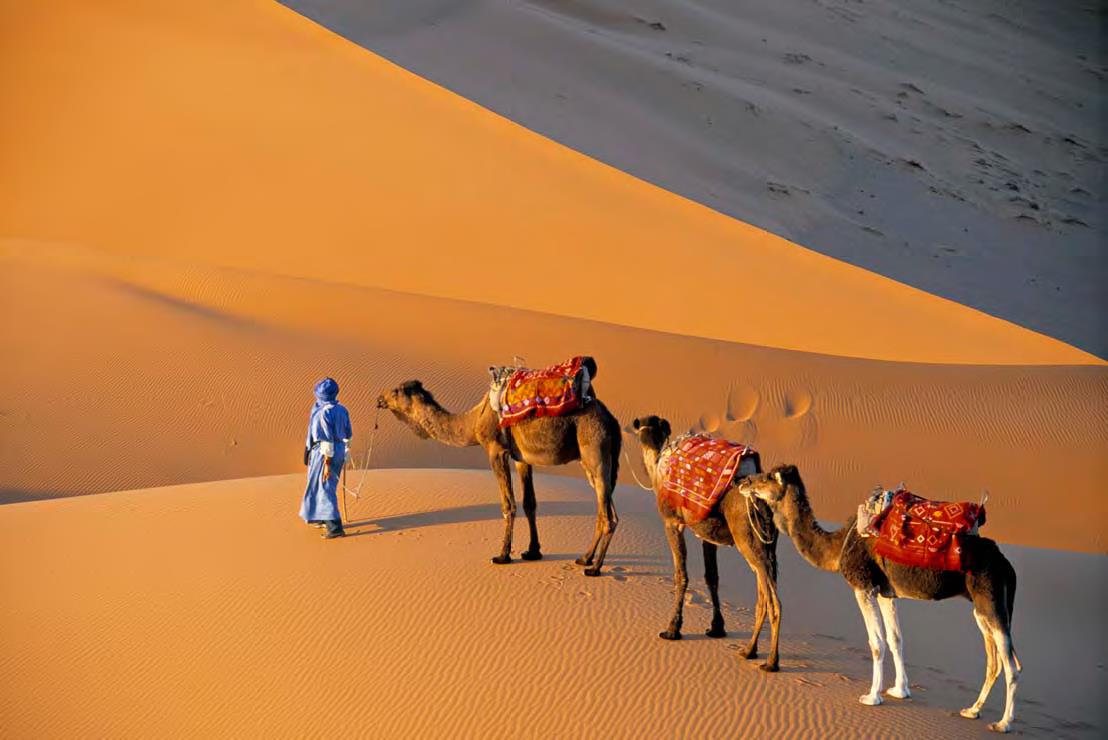
Tonight dine under the stars to the sounds of local musicians, and bed down in Bedouin-style tents. Each simple-but-comfortable shelter is appointed with lanterns, beds, plenty of blankets, and an en-suite bathroom with a flushing toilet and washbasin. Total drive time: 8 hours on good paved roads, not including rest stops, then 30 minutes by 4x4 vehicle on unpaved desert track. Berber-Style Desert Tented Camp (B,L,D)
Day 5: Route des Kasbahs and Ouarzazate
Today you can climb aboard a camel for a short, gentle ride to the crest of the dunes. From this incredible vantage point, greet the sun and watch it paint the mountains of Saharan sand with glowing reds and ambers. Afterward, return to camp.
Next depart for the town of Tinerhir, tucked in the Atlas Mountains. Your six- to seven-hour drive takes you through the scenic Todra Gorge and Dadès Valley, dotted with picturesque casbahs and ksars (fortified earthen villages). Continue following the Route des Kasbahs. Farther along, stretch your legs with a walk through a date oasis to seldom-visited Amerhidil, one of the largest, most decorated casbahs in Morocco.
Next you arrive in Ouarzazate, a garrison town built by the French in the 1920s, and check into Le Temple des Arts. This boutique hotel, stylishly constructed in the local architectural vernacular, features just seven rooms, each inspired by great movies filmed in the area. Total drive time: 6.5 hours on well paved roads. Le Temple des Arts (B)
Day 6: High Atlas Mountains
Take a short drive to the World Heritage Site of Aït Benhaddou, perhaps the most impressive ksar (castle) of Morocco. “It is an extraordinary ensemble of buildings offering a complete panorama of pre-Saharan earthen construction techniques,” according to UNESCO. Cross the Oued El Maleh, the stream in front of the walled entry, and take a stroll through the ksar, examining the mud construction and striking architecture of the tightly knit houses - some of which resemble small castles.
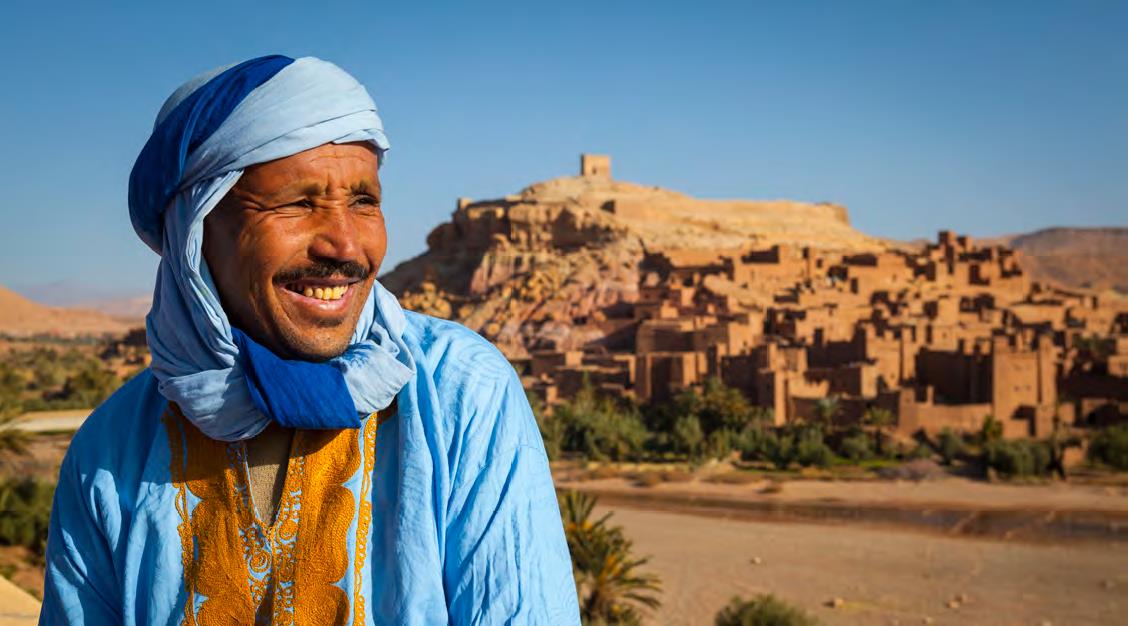
Pressing on, enter the natural drama of Toubkal National Park in the High Atlas Mountains and your home for the next two nights, Kasbah du Toubkal. Kasbah du Toubkal is beyond the main road system and has breathtaking views from its perch at the foot of Jebel Toubkal, the highest peak in North Africa. The lodge features classic Berber hospitality with kindness and warmth for each guest. The Kasbah has been transformed, using traditional methods, from the home of a feudal caid into a haven for guests. It is not a hotel in the traditional sense, but more an extension of the hospitality that stems from the home of the Berbers who run it. Rooms are very simply appointed in a clean, rustic style that reflects the area, and have en-suite bathrooms with tub. Total drive time: 5 hours on good paved roads.
Kasbah du Toubkal (B)
Day 7: High Atlas Mountains
The High Atlas Mountains, so important to Marrakech, can often be seen from the city, and the views are magnificent. However, a whole new experience awaits those who venture into them. From the village of Imlil, footpaths and mule tracks mount through lush, irrigated terraces, apple orchards, and walnut groves to other villages, where the way of life has changed little for centuries, and traditional values and hospitality are unaffected by the outside world. Spend a full day exploring the village, nearby hamlets, and the surrounding mountain landscape, on foot or by mule, or just put your feet up and relax on the terrace or in the hammam. Kasbah du Toubkal (B,L)
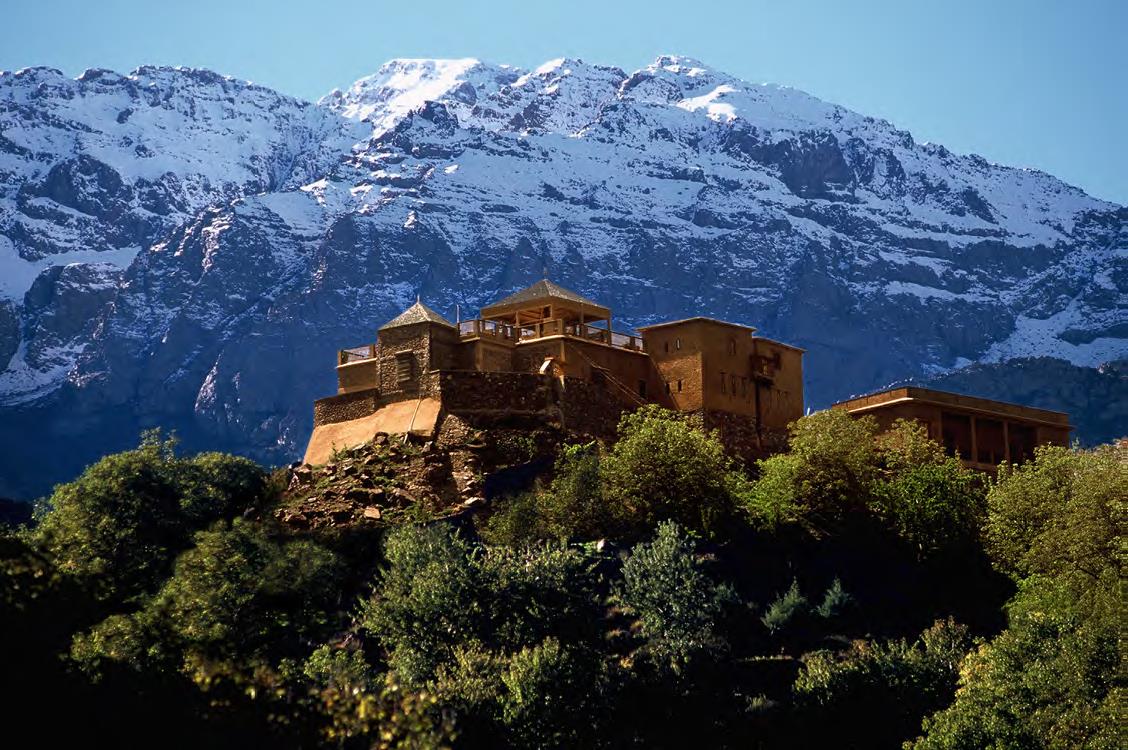
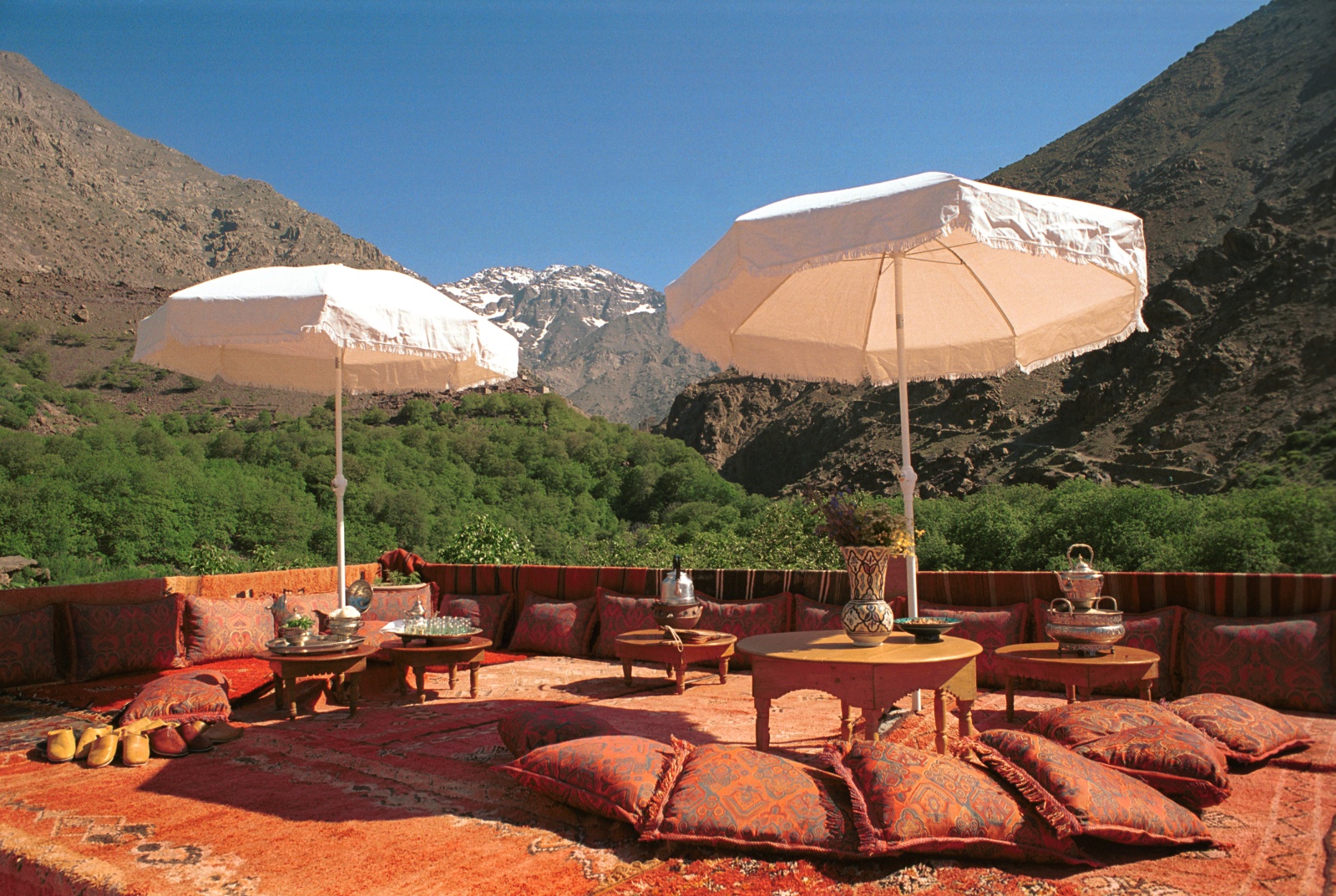
Day 8: Marrakech
Take a short drive down through the foothills to Marrakech, the “Pearl of the South.” English writer Osbert Sitwell wrote admiringly that Marrakech was “in many respects the ideal African city of water-lawns, cool pillared palaces, and orange groves situated in a superb oasis between two snow-capped ranges.”
Refresh yourself at Jardin Majorelle, the lush jewel box for the plant collections of expatriate French painter Jacques Majorelle. 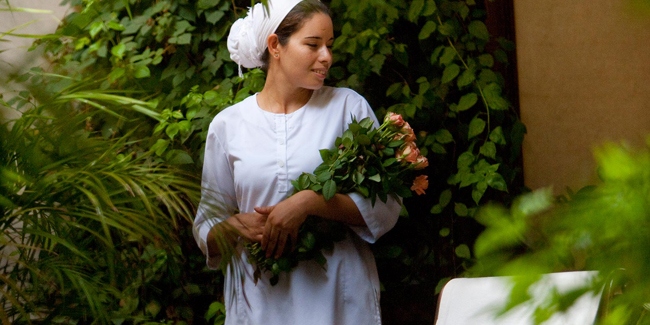 Then check out its museum, recently renovated to showcase the exquisite Berber arts collection of the late Yves Saint Laurent and Pierre Bergé, who restored the garden to its current splendor.
Then check out its museum, recently renovated to showcase the exquisite Berber arts collection of the late Yves Saint Laurent and Pierre Bergé, who restored the garden to its current splendor.
You’ll be residing at La Villa des Orangers, a luxury five-star hotel and riad located in the heart of Marrakech. Everything has been carefully chosen to make your stay relaxing and sophisticated: an elegant decor, delicious cuisine, a large garden, courtyards, three swimming pools, a traditional Moroccan hammam, massage rooms, beauty salon, gym, and an open bar to enjoy a mint tea with Moroccan pastries during the day.
La Villa des Orangers (B)
Day 9: Marrakech
Today venture to the late-19th-century Palais Bahia, noted for its Moorish-Andalusian architecture and resplendent gardens. Carved stucco, sculpted and painted woodwork, and glazed ceramic tile abound, blending themes and techniques of Moroccan architecture and Spanish Nasrid Dynasty palace architecture.
You’ll also visit the Saadian Tombs, where princes were buried as early as 1557. The Saadians of southern Morocco ruled the land in the 16th century. Next spend time investigating the Museum of Moroccan Arts, which is housed in the Dar Si Saïd, a 19th-century palace. Winding through the souk’s labyrinthine streets, you work your way to the city’s famed main square, Djemaa El-Fna. Each morning a large market unfolds here with stalls selling nuts, orange juice, and medicinal plants. But as dusk falls, strings of lights flicker on, and the square becomes a veritable open-air circus with snake charmers, monkeys and their handlers, jugglers, musicians, dancers, acrobats, storytellers, and riveted onlookers. Fragrant smoke rises from the food vendors’ stalls - the best ones crowded with locals hungrily hunched over bowls. La Villa des Orangers (B)
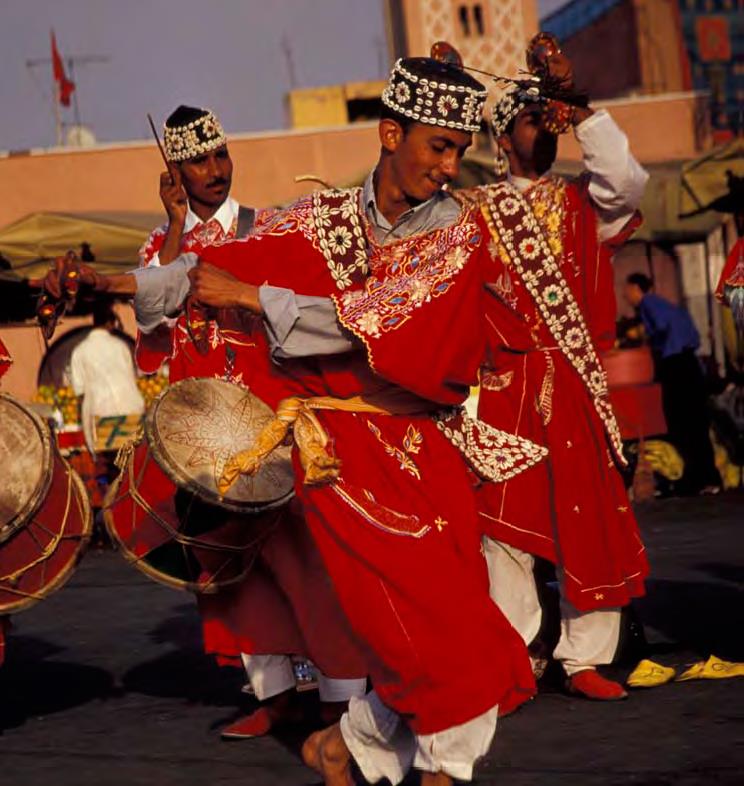
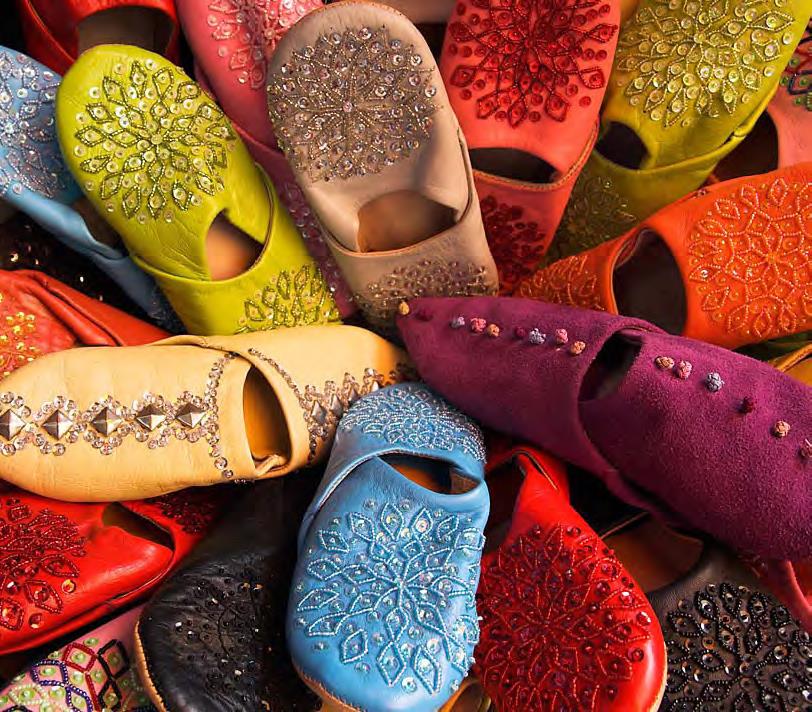
Day 10: Marrakech
In Flavors of Morocco, Ghillie Bașan wrote “Moroccan cooks use every spice that ever found its way across the Sahara desert or over the Mediterranean, blending the influences of the different cultures that have left their culinary mark: Berber, Arab, Moorish, Jewish, French, Ottoman, and Spanish.” Kick off the day with a cooking demonstration and hands-on class. The chef introduces you to the ingredients and finer points of traditional dishes.
Next you may return to the souk, relax at your riad, or take a horse-drawn carriage ride through La Palmeraie, a date-palm oasis on the outskirts of Marrakech where many European families - including the Rothschilds and the Hermès - have winter villas.
Later make an excursion to Maison Tiskiwin to view the private collection of Bert Flint, a Dutch professor and renowned collector 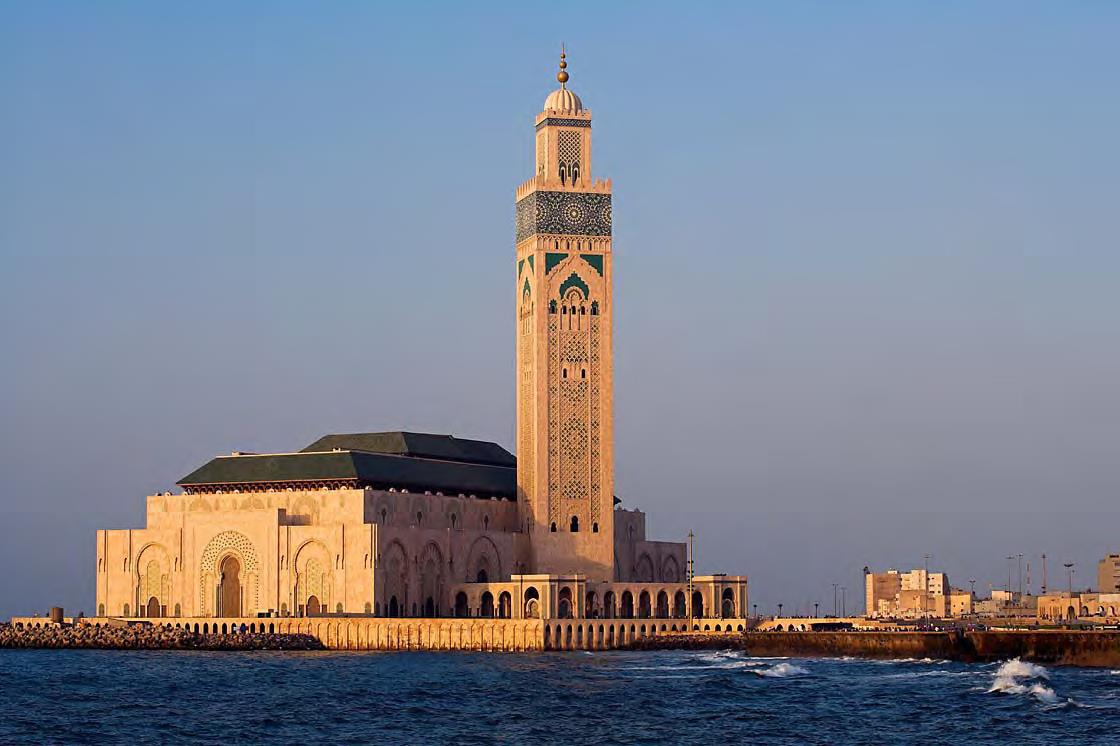 of Moroccan folk art and artifacts from the Souss Valley and Saharan region. Return to your riad to refresh before your festive farewell dinner.
of Moroccan folk art and artifacts from the Souss Valley and Saharan region. Return to your riad to refresh before your festive farewell dinner.
La Villa des Orangers (B,L)
Day 11: Casablanca
Today you will return to Casablanca for your flights home. If time permits, visit the Hassan II mosque. This marvel of traditional design and modern engineering is built on the Atlantic - literally. Inspired by a verse in the Qur’an, it juts into the water atop reclaimed land. Remove your shoes to walk through the mosque, one of the world’s largest religious buildings and one of the few in Morocco that is open to non-Muslim visitors. It can accommodate 25,000 worshipers within its confines, adorned with zellij tile work, marble arches and columns, decorative fountains, carved wood and stucco, and a 656-foot-tall minaret. After marveling at this house of worship’s immensity and craftsmanship, transfer to the airport to connect with your international flight homeward. (B,L)
Comfort Level
This trip is moderate touring. The hotels and riads used are first-class wherever possible, roads are good, and service is generally polite and friendly. In the riads, the size and type of rooms vary, as these are converted private houses of individual character with family-style hospitality.
Please be aware that there are several days of lengthy driving on this trip; approximate times are noted. The overland journey days are an unavoidable fact of Morocco’s topography and our comprehensive itinerary. The routes are very scenic for the most part, and drives are broken up by comfort and photo stops. Some mountain roads are quite winding; maximum altitude is approximately 6,000 feet. For 2–4 guests, we use a comfortable, air-conditioned Mercedes Vito van; for 5–7 guests, we use a 17-seat minivan. In the larger vehicles, every guest has a window seat with an extra seat to stretch out, and plenty of room for luggage.
in association with Geo-Ex (Geographic Expeditions)

 short notice as no entry visa is required.
short notice as no entry visa is required. 
 1864, it houses the offices of the Moroccan government and is set among beautiful gardens. From here move on to Hassan Tower, the emblem of Rabat, a massive but only partially built minaret of the vast, never-completed 12th-century Hassan Mosque. Next, venture to the adjacent Mohammed V Mausoleum, home to the marble sarcophagus of independent Morocco’s first king. Royal guards stand at attention as Moroccans pay their respects and admire the artistry of the building. Walk through Bab Ouadaïa, the grand Almohad gate that leads into Ouadaïa, site of Rabat’s original citadel. Once inside, head to the National Jewelry Museum to check out its collection before relaxing in the casbah’s classical Andalusian garden with a revitalizing glass of mint tea.
1864, it houses the offices of the Moroccan government and is set among beautiful gardens. From here move on to Hassan Tower, the emblem of Rabat, a massive but only partially built minaret of the vast, never-completed 12th-century Hassan Mosque. Next, venture to the adjacent Mohammed V Mausoleum, home to the marble sarcophagus of independent Morocco’s first king. Royal guards stand at attention as Moroccans pay their respects and admire the artistry of the building. Walk through Bab Ouadaïa, the grand Almohad gate that leads into Ouadaïa, site of Rabat’s original citadel. Once inside, head to the National Jewelry Museum to check out its collection before relaxing in the casbah’s classical Andalusian garden with a revitalizing glass of mint tea. have been dreamed up by Edgar Allan Poe - almost sinister in its secretiveness, a twisted city, warped and closed.” Strolling through Fès’ honeycomb of tiny lanes and crowded bazaars, you’ll be glad to have a guide. Find your way to the vibrant Tannery Quarter, where leather is made much the same way it was in the Middle Ages.
have been dreamed up by Edgar Allan Poe - almost sinister in its secretiveness, a twisted city, warped and closed.” Strolling through Fès’ honeycomb of tiny lanes and crowded bazaars, you’ll be glad to have a guide. Find your way to the vibrant Tannery Quarter, where leather is made much the same way it was in the Middle Ages.



 Then check out its museum, recently renovated to showcase the exquisite Berber arts collection of the late Yves Saint Laurent and Pierre Bergé, who restored the garden to its current splendor.
Then check out its museum, recently renovated to showcase the exquisite Berber arts collection of the late Yves Saint Laurent and Pierre Bergé, who restored the garden to its current splendor. 

 of Moroccan folk art and artifacts from the Souss Valley and Saharan region. Return to your riad to refresh before your festive farewell dinner.
of Moroccan folk art and artifacts from the Souss Valley and Saharan region. Return to your riad to refresh before your festive farewell dinner. 





